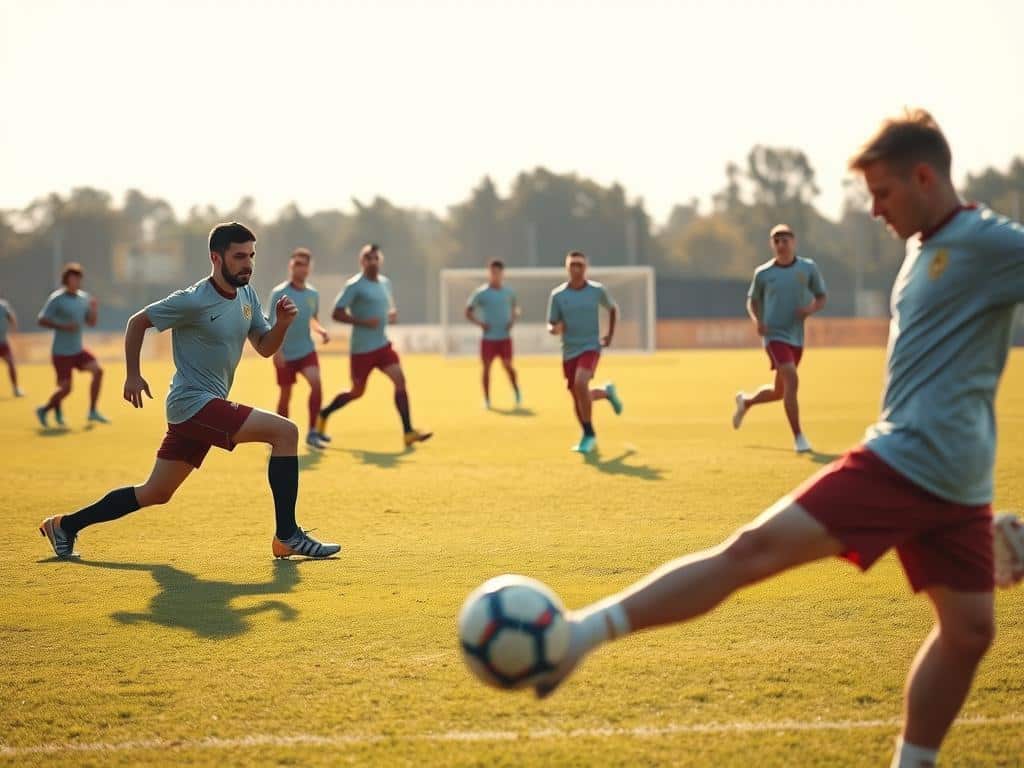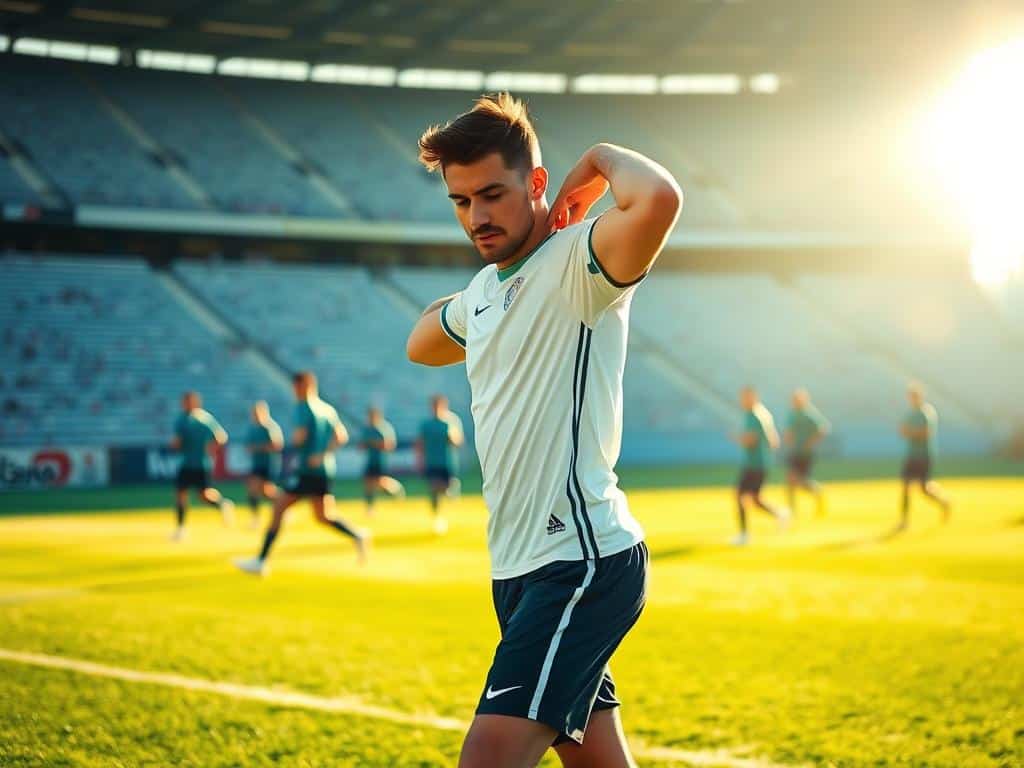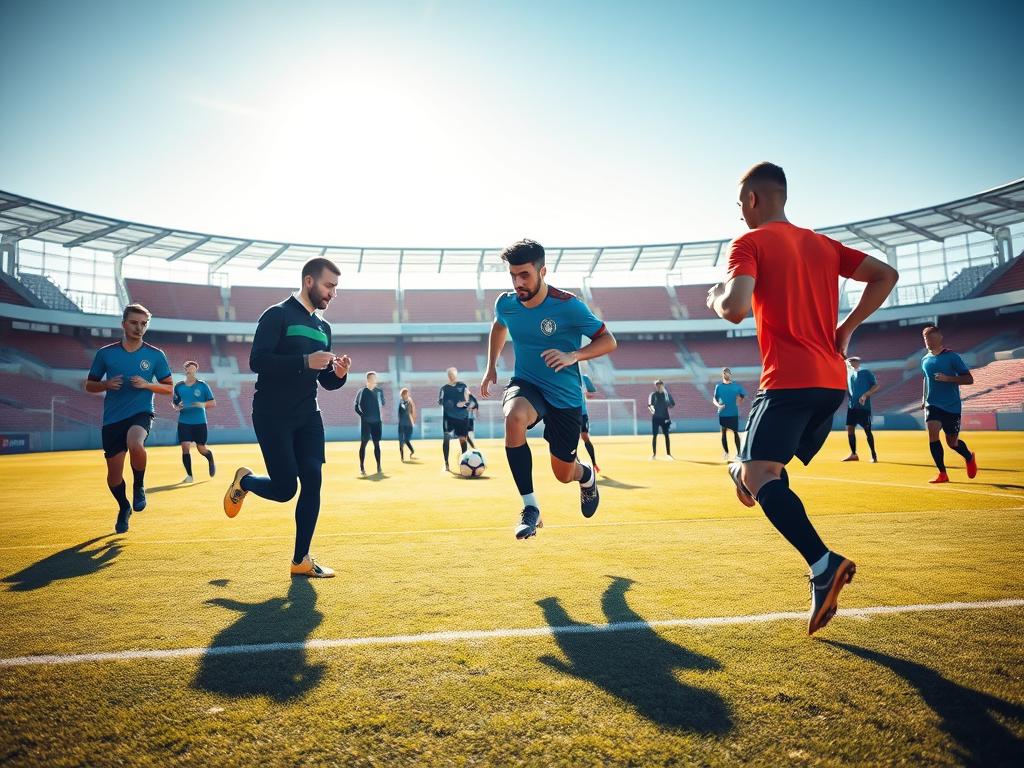Surprising fact: a 10–15 minute dynamic warm-up can raise heart rate, boost blood flow and prime your nervous system in ways that change how you perform from the first whistle!
Want to feel sharper when the game starts? Use the right routine and you’ll ramp up performance fast while keeping your body ready for the field.
Dynamic drills like high knees, butt kicks, leg swings and arm circles activate the muscles you use most. Spend about 20–30 seconds per move and stay in controlled, non‑painful ranges.
We’ll show moves that prep joints and tendons, protect knees and hips, and cut risk without wasting time. These are simple cues you can use at practice or before a match.
Key Takeaways
- Ten to fifteen minutes of dynamic work primes heart rate and muscle temperature.
- Use controlled ranges and avoid pushing into pain to lower injury risk.
- Short, sport-specific drills improve on-field performance quickly.
- Focus on movements that mirror cuts, sprints, and direction changes.
- Do about 20–30 seconds per drill for optimal readiness.
Why Flexibility Matters Right Now for Soccer Players
Match play’s stop-start demands put players at higher risk for sprains, strains, and overuse. Rapid cuts and sprint bursts challenge the muscles and joints every minute. Understanding those threats is step one toward prevention.
Good mobility expands usable range for sprints, cuts, and deceleration. That means your body handles motion at game speed with less compensation and fewer nagging injuries.
- Better range spreads load across muscles and joints, lowering injury risk from sudden direction changes.
- Freer motion improves reaction time, giving you more agility and speed in tight spaces.
- Open hips and ankles produce cleaner first steps and sharper turns under pressure.
- Enhanced circulation helps muscles fire on demand and recover faster after training.
Simply put: working on mobility delivers immediate performance gains and long-term protection. Make this part of your regular training to stay available and effective on the field.
Dynamic vs. Static: The Stretching Strategies Soccer Players Need
How you prepare before kickoff changes your speed, balance, and injury risk. Choose the right approach and you protect joints while boosting performance. This section breaks down when to use active work and when to slow down.
Dynamic warm-ups: priming joints, muscle, and the nervous system
Dynamic work uses active, controlled motion that mirrors the game. Do 10–15 minutes before practice or match play. Move for about 20–30 seconds per exercise and progress gradually without discomfort.
Think flowing leg actions that wake the nervous system and raise temperature. Keep rhythm and control—no whipping or forcing end-range. This routine readies muscles for accelerations and quick changes of direction.
Static holds: cooldowns and safe range expansion
Save static holds for after training. With tissues warm, longer holds help expand range safely without deadening readiness for the next session.
- Post-session static work supports recovery and long-term mobility benefits.
- Avoid locking joints; keep alignment controlled to protect the leg and hip.
- Smart sequencing pairs dynamic pre-game work with targeted post-game holds for lasting injury prevention.
soccer flexibility stretches That Belong in Every Warm-Up
Get your legs game-ready with a set of quick, active drills that map to real field demands. These moves prime hips, knees, hamstrings, and core without stealing time.

Butt kicks
Jog in place, keep your torso tall, and snap heels toward the glutes. This warms the backside chain and grooves knee motion.
High knees
Jog with high knees, driving the thigh and tightening the core. Use short, quick reps to rehearse sprint mechanics and first steps.
Walking toe touch
Take small forward steps, hinge at the hips, and reach toward toes. This lengthens the posterior chain while teaching a clean hip hinge.
Closed-knees and open-knees leg drives
Closed-knees: swing leg forward to about 90° then back under control. Open-knees: sweep inward across the body, then outward in a semi-circle. Both build controlled motion for cutting and stride power.
Leg swings, lateral hip swings, and arm circles
Forward-back leg swings start small, then grow in height. Lateral swings target side-to-side cutting angles—use a wall or post for balance. Finish with arm circles to cue posture and upper-body readiness.
Quick checklist:
- Keep feet under you and avoid yanking at end range.
- One foot grounded, one in smooth motion—feel the movement.
- Aim 20–30 seconds per drill for optimal warm-up value.
| Drill | Primary Target | How to Perform | Warm-up Benefit |
|---|---|---|---|
| Butt kicks | Hamstrings, knee | Jog in place, heels to glutes | Grooves knee motion |
| High knees | Hip flexors, core | Drive knees up, quick rhythm | Improves sprint start |
| Leg swings (F-B & lateral) | Hips, hamstrings, quads | Pendulum motion, progress height | Safe mobility for cuts |
| Walking toe touch / Arm circles | Posterior chain / Shoulders | Small steps hinge / T-arm circles | Hip hinge control / Postural prep |
Targeted Stretches for Injury Prevention on the Soccer Field
Small, focused moves can stop nagging pain before it turns into a game‑limiting injury. These three targets address common weak spots in players: the front of the hip, the lower leg, and deep glute tissue.
Kneeling hip flexor stretch
Start in a lunge with both knees near 90°. Engage your core and tuck the pelvis slightly. Push the hips forward and breathe.
Raise the same‑side arm and lean gently away to deepen the line. Hold 20–30 seconds on each side to restore hip flexors for stronger kicking and sprinting mechanics.
Calf raises and drops
Stand on a step with the forefoot. Rise to tiptoes with control, then lower heels below the edge without bouncing.
Use slow eccentrics to load the calves and Achilles. This builds resilient lower‑leg muscles for quick accelerations and safer stops.
Seated piriformis stretch
Sit tall and cross one leg over the other. Gently press the knee or hinge from the hips to target the deep glute.
Lean forward from the hips — not the back — to ease tension that can irritate the sciatic pathway. Breathe and repeat both sides.
- The combo lowers injury risk by bulletproofing common weak links in the legs.
- Use these moves post‑training or as part of a weekly plan for steady benefits.
| Move | Primary Target | How to Perform |
|---|---|---|
| Kneeling hip flexor | Hip flexors, front of hip | Lunge, core on, overhead reach, hold 20–30 seconds |
| Calf raises & drops | Calves, Achilles, feet | Step tiptoe up, slow drop below edge, no bounce |
| Seated piriformis | Deep glute, sciatic pathway | Cross leg, hinge from hips, breathe and hold |
Yoga-Based Stretches Soccer Players Use for Range of Motion and Recovery
Yoga offers simple poses that blend strength, posture, and hip opening for better motion and recovery. Want moves you can do on the ground in minutes?
Downward Facing Dog
Form an inverted V to lengthen calves and hamstrings while resetting posture. Breathe slow and push hips up and back for a full posterior-chain reset.
Benefit: Calms the nervous system and primes speed by improving ankle and back mobility.
Pigeon Pose
Pigeon targets deep hip rotators and hip flexors so the hips feel freer. Hold gently and avoid forcing the front hip.
Warrior I
This pose builds leg strength and core stability while opening the groin. It helps balance and power for quick directional changes on the field.
Half Front Splits (Ardha Hanumanasana)
Focuses the hamstring safely to support kicking mechanics. Short holds two to three times per week yield steady gains and fewer injuries.
- Practice on the ground with controlled breathing to unlock range without strain.
- Keep the back long and ribs stacked—posture turns each pose into a performance booster.
| Pose | Primary Target | Hold/Benefit |
|---|---|---|
| Downward Dog | Hamstrings, calves, back | 30–60 seconds: posterior-chain reset |
| Pigeon | Hips, glute rotators | 30 seconds each: hip mobility |
| Warrior I | Legs, core, groin | 20–30 seconds: stability + power |
| Half Front Splits | Hamstring, back of leg | 20–30 seconds: safer kicking |
When to Stretch and How Long to Hold for Game-Day Performance
Timing your warm-up and cooldown changes how fast and fresh you feel at kickoff. A smart plan keeps your body primed without draining energy. Follow simple rules and you get more out of every minute on the field.

Pre-practice and pre-match
Do 10–15 minutes of dynamic work that mirrors play. Keep motions crisp and controlled to wake the nervous system. Use drills that rehearse sprints, cuts, and planting mechanics.
Post-training
Switch to static holding after sessions. Hold 15–30 seconds per side to safely expand range and aid recovery. Focus on hip flexors, calves, and hips to protect stride length and reduce injury risk.
Off-days
Add short yoga sessions 2–3 times weekly. These sessions build range of motion and mental focus without fatigue. They deliver steady benefits when done often.
- Before the match: 10–15 minutes dynamic routine that mimics movements.
- After practice: 15–30 second static holds per side for safe gains.
- Off-days: yoga 2–3x/week to boost mobility and calm the mind.
| Timing | Duration | Main Goal |
|---|---|---|
| Pre-match / Pre-practice | 10–15 minutes | Activate muscles and nervous system for performance |
| Post-training | 15–30 seconds per side | Increase range of motion and support recovery |
| Off-days | 20–30 minutes, 2–3x/week | Mobility, breath work, and mental focus |
Keep it consistent. Small, repeatable sessions beat long, rare efforts. For more on gear and groin risk, read this cleats and groin risk guide.
Form and Safety Tips to Reduce Risk and Maximize Results
Keep control and posture first; everything else improves faster and safer. Good form protects joints and gets better benefits from every drill. These quick cues keep players ready and reduce injury risk.
Avoid locking joints; control the range and tempo
Don’t lock the joints—use soft knees and steady tempo. Small, deliberate motion protects tissues and trains useful movement patterns.
After training, use a hold stretch of 15–30 seconds when warm. Breathe and never force end range.
Use support (wall, fence, goalpost) to maintain alignment
Use a wall, fence, or goalpost for balance during leg swings and calf work. Hands-on support keeps alignment honest and helps feet track under the hips.
Keep your back long and ribs stacked. Small hip and knee tweaks turn an okay drill into a great one for performance and injury prevention.
- Soft knees protect the knees and reduce strain.
- Feel the feet connect to the ground; guide knee tracking.
- Move deliberately—tempo matters more than massive range motion.
| Focus | Tip | Benefit |
|---|---|---|
| Joints | Keep soft knees, avoid locking | Lower risk, cleaner technique |
| Support | Use wall or post for balance | Better alignment, safer motion |
| Posture | Back long, ribs stacked | Improved muscle engagement |
Sample Soccer Stretching Routine You Can Use on the Field
A quick, repeatable routine can make you feel looser and sharper in ten minutes flat. Use this flow before practice and the cooldown after to get the most performance benefit from every session.
Dynamic warm-up flow
Start jogging in place with high knees, then switch to butt kicks to wake up stride mechanics and coordination.
Follow with forward-back leg swings and lateral hip swings. Begin small and grow the range while using a post for balance.
Finish the warm-up with arm circles forward and backward to prep the shoulder girdle and aid balance during aerial plays.
Post-session cooldown
Begin with a kneeling hip flexor reach: lift the arm and lean slightly to open the front of the hips.
Slide into Half Front Splits for the hamstrings. Keep the back long and avoid forcing depth.
Use Pigeon to free hip rotation and calm deep glute tension. End on a calf routine—slow raises and controlled drops on a step or wall.
Quick routine benefits:
- Works anywhere on the field and fits before or after training.
- Improves knee tracking, foot path, and overall agility.
- Compact and repeatable for steady gains in performance and recovery.
| Phase | Key Moves | Duration | Primary Benefit |
|---|---|---|---|
| Warm-up | High knees, butt kicks, leg swings, lateral swings, arm circles | 10–15 minutes total | Activate legs, hips, and nervous system for play |
| Cooldown | Kneeling hip flexor, Half Front Splits, Pigeon, calf raises/drops | 10 minutes | Restore range, reduce soreness, support recovery |
| Anywhere | Post or wall for balance | Ongoing | Cleaner lines and safer motion for each leg |
Take the Field Looser, Faster, and More Resilient
A simple, consistent routine is the secret to feeling quicker and staying healthy on match day. Do dynamic warm-ups before training or a game and finish with targeted static holds after.
Add short yoga sessions 2–3 times weekly to support recovery, improve range of motion, and sharpen focus between sessions.
Expect more fluid movements, faster first steps, and cleaner changes of direction. Flexible hips and calves help your speed and agility without extra risk.
Stay intentional and consistent: use the same flow each day and track small gains. Ready to roll? Lace up, own your warm-up, and take the field looser, faster, and more resilient.







